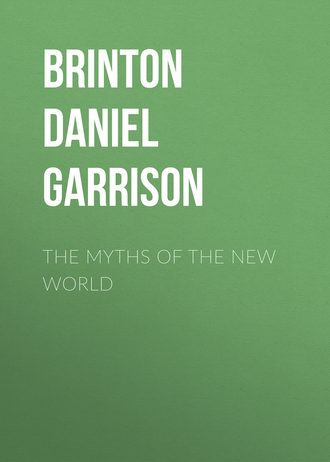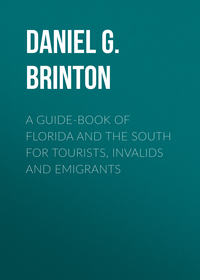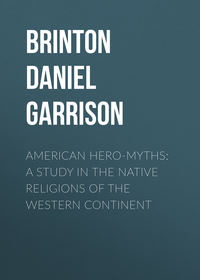 полная версия
полная версияThe Myths of the New World
The use of such “holy water” astonished the Romanist missionaries, and they at once detected Satan parodying the Scriptures. But their astonishment rose to horror when they discovered among various nations a rite of baptism of appalling similarity to their own, connected with the imposing of a name, done avowedly for the purpose of freeing from inherent sin, believed to produce a regeneration of the spiritual nature, nay, in more than one instance called by an indigenous word signifying “to be born again.”164 Such a rite was of immemorial antiquity among the Cherokees, Aztecs, Mayas, and Peruvians. Had the missionaries remembered that it was practised in Asia with all these meanings long before it was chosen as the sign of the new covenant, they need have invoked neither Satan nor Saint Thomas to explain its presence in America.
As corporeal is near akin to spiritual pollution, and cleanliness to godliness, ablution preparatory to engaging in religious acts came early to have an emblematic as well as a real significance. The water freed the soul from sin as it did the skin from stain. We should come to God with clean hands and a clean heart. As Pilate washed his hands before the multitude to indicate that he would not accept the moral responsibility of their acts, so from a similar motive a Natchez chief, who had been persuaded against his sense of duty not to sacrifice himself on the pyre of his ruler, took clean water, washed his hands, and threw it upon live coals.165 When an ancient Peruvian had laid bare his guilt by confession, he bathed himself in a neighboring river and repeated this formula:—
“O thou River, receive the sins I have this day confessed unto the Sun, carry them down to the sea, and let them never more appear.”166
The Navajo who has been deputed to carry a dead body to burial, holds himself unclean until he has thoroughly washed himself in water prepared for the purpose by certain ceremonies.167 A bath was an indispensable step in the mysteries of Mithras, the initiation at Eleusis, the meda worship of the Algonkins, the Busk of the Creeks, the ceremonials of religion everywhere. Baptism was at first always immersion. It was a bath meant to solemnize the reception of the child into the guild of mankind, drawn from the prior custom of ablution at any solemn occasion. In both the object is greater purity, bodily and spiritual. As certainly as there is a law of conscience, as certainly as our actions fall short of our volitions, so certainly is man painfully aware of various imperfections and shortcomings. What he feels he attributes to the infant. Avowedly to free themselves from this sense of guilt the Delawares used an emetic (Loskiel), the Cherokees a potion cooked up by an order of female warriors (Timberlake), the Takahlies of Washington Territory, the Aztecs, Mayas, and Peruvians, auricular confession. Formulize these feelings and we have the dogmas of “original sin,” and of “spiritual regeneration.” The order of baptism among the Aztecs commenced, “O child, receive the water of the Lord of the world, which is our life; it is to wash and to purify; may these drops remove the sin which was given to thee before the creation of the world, since all of us are under its power;” and concluded, “Now he liveth anew and is born anew, now is he purified and cleansed, now our mother the Water again bringeth him into the world.”168
A name was then assigned to the child, usually that of some ancestor, who it was supposed would thus be induced to exercise a kindly supervision over the little one’s future. In after life should the person desire admittance to a superior class of the population and had the wealth to purchase it—for here as in more enlightened lands nobility was a matter of money—he underwent a second baptism and received another name, but still ostensibly from the goddess of water.169
In Peru the child was immersed in the fluid, the priest exorcised the evil and bade it enter the water, which was then buried in the ground.170 In either country sprinkling could take the place of immersion. The Cherokees believe that unless the rite is punctually performed when the child is three days old, it will inevitably die.171
As thus curative and preservative, it was imagined that there was water of which whoever should drink would not die, but live forever. I have already alluded to the Fountain of Youth, supposed long before Columbus saw the surf of San Salvador to exist in the Bahama Islands or Florida. It seems to have lingered long on that peninsula. Not many years ago, Coacooche, a Seminole chieftain, related a vision which had nerved him to a desperate escape from the Castle of St. Augustine. “In my dream,” said he, “I visited the happy hunting grounds and saw my twin sister, long since gone. She offered me a cup of pure water, which she said came from the spring of the Great Spirit, and if I should drink of it, I should return and live with her forever.”172 Some such mystical respect for the element, rather than as a mere outfit for his spirit home, probably induced the earlier tribes of the same territory to place the conch-shell which the deceased had used for a cup conspicuously on his grave,173 and the Mexicans and Peruvians to inter a vase filled with water with the corpse, or to sprinkle it with the liquid, baptizing it, as it were, into its new associations.174 It was an emblem of the hope that should cheer the dwellings of the dead, a symbol of the resurrection which is in store for those who have gone down to the grave.
The vase or the gourd as a symbol of water, the source and preserver of life, is a conspicuous figure in the myths of ancient America. As Akbal or Huecomitl, the great or original vase, in Aztec and Maya legends it plays important parts in the drama of creation; as Tici (Ticcu) in Peru it is the symbol of the rains, and as a gourd it is often mentioned by the Caribs and Tupis as the parent of the atmospheric waters.
As the Moon is associated with the dampness and dews of night, an ancient and wide-spread myth identified her with the Goddess of Water. Moreover, in spite of the expostulations of the learned, the common people the world over persist in attributing to her a marked influence on the rains. Whether false or true, this familiar opinion is of great antiquity, and was decidedly approved by the Indians, who were all, in the words of an old author, “great observers of the weather by the moon.”175 They looked upon her not only as forewarning them by her appearance of the approach of rains and fogs, but as being their actual cause.
Isis, her Egyptian title, literally means moisture; Ataensic, whom the Hurons said was the moon, is derived from the word for water; and Citatli and Atl, moon and water, are constantly confounded in Aztec theology. Their attributes were strikingly alike. They were both the mythical mothers of the race, and both protect women in child-birth, the babe in the cradle, the husbandman in the field, and the youth and maiden in their tender affections. As the transfer of legends was nearly always from the water to its lunar goddess, by bringing them in at this point their true meaning will not fail to be apparent.
We must ever bear in mind that the course of mythology is from many gods toward one, that it is a synthesis not an analysis, and that in this process the tendency is to blend in one the traits and stories of originally separate divinities. As has justly been observed by the Mexican antiquarian Gama: “It was a common trait among the Indians to worship many gods under the figure of one, principally those whose activities lay in the same direction, or those in some way related among themselves.”176
The time of full moon was chosen both in Mexico and Peru to celebrate the festival of the deities of water, the patrons of agriculture,177 and very generally the ceremonies connected with the crops were regulated by her phases. The Nicaraguans said that the god of rains, Quiateot, rose in the east,178 thus hinting how this connection originated. At a lunar eclipse the Orinoko Indians seized their hoes and labored with exemplary vigor on their growing corn, saying the moon was veiling herself in anger at their habitual laziness;179 and a description of the New Netherlands, written about 1650, remarks that the savages of that land “ascribe great influence to the moon over crops.”180 This venerable superstition, common to all races, still lingers among our own farmers, many of whom continue to observe “the signs of the moon” in sowing grain, setting out trees, cutting timber, and other rural avocations.
As representing water, the universal mother, the moon was the protectress of women in child-birth, the goddess of love and babes, the patroness of marriage. To her the mother called in travail, whether by the name of “Diana, diva triformis” in pagan Rome, by that of Mama Quilla in Peru, or of Meztli in Anahuac. Under the title of Yohualticitl, the Lady of Night, she was also in this latter country the guardian of babes, and as Teczistecatl, the cause of generation.181
Very different is another aspect of the moon goddess, and well might the Mexicans paint her with two colors. The beneficent dispenser of harvests and offspring, she nevertheless has a portentous and terrific phase. She is also the goddess of the night, the dampness, and the cold; she engenders the miasmatic poisons that rack our bones; she conceals in her mantle the foe who takes us unawares; she rules those vague shapes which fright us in the dim light; the causeless sounds of night or its more oppressive silence are familiar to her; she it is who sends dreams wherein gods and devils have their sport with man, and slumber, the twin brother of the grave. In the occult philosophy of the middle ages she was “Chief over the Night, Darkness, Rest, Death, and the Waters;”182 in the language of the Algonkins, her name is identical with the words for night, death, cold, sleep, and water.183
She is the evil minded woman who thus brings diseases upon men, who at the outset introduced pain and death in the world—our common mother, yet the cruel cause of our present woes. Sometimes it is the moon, sometimes water, of whom this is said: “We are all of us under the power of evil and sin, because we are children of the Water,” says the Mexican baptismal formula. That Unktahe, spirit of water, is the master of dreams and witchcraft, is the belief of the Dakotas.184 A female spirit, wife of the great manito whose heart is the sun, the ancient Algonkins believed brought death and disease to the race; “it is she who kills men, otherwise they would never die; she eats their flesh and knaws their vitals, till they fall away and miserably perish.”185 Who is this woman? In the legend of the Muyscas it is Chia, the moon, who was also goddess of water and flooded the earth out of spite.186 Her reputation was notoriously bad. The Brazilian mother carefully shielded her infant from the lunar rays, believing that they would produce sickness;187 the hunting tribes of our own country will not sleep in its light, nor leave their game exposed to its action. We ourselves have not outgrown such words as lunatic, moon-struck, and the like. Where did we get these ideas? The philosophical historian of medicine, Kurt Sprengel, traces them to the primitive and popular medical theories of ancient Egypt, in accordance with which all maladies were the effects of the anger of the goddess Isis, the Moisture, the Moon.188
We have here the key to many myths. Take that of Centeotl, the Aztec goddess of Maize. She was said at times to appear as a woman of surpassing beauty, and allure some unfortunate to her embraces, destined to pay with his life for his brief moments of pleasure. Even to see her in this shape was a fatal omen. She was also said to belong to a class of gods whose home was in the west, and who produced sickness and pains.189 Here we see the evil aspect of the moon reflected on another goddess, who was at first solely the patroness of agriculture.
As the goddess of sickness, it was supposed that persons afflicted with certain diseases had been set apart by the moon for her peculiar service. These diseases were those of a humoral type, especially such as are characterized by issues and ulcers. As in Hebrew the word accursed is derived from a root meaning consecrated to God, so in the Aztec, Quiché, and other tongues, the word for leprous, eczematous, or syphilitic, means also divine. This bizarre change of meaning is illustrated in a very ancient myth of their family. It is said that in the absence of the sun all mankind lingered in darkness. Nothing but a human sacrifice could hasten his arrival. Then Metzli, the moon, led forth one Nanahuatl, the leprous, and building a pyre, the victim threw himself in its midst. Straightway Metzli followed his example, and as she disappeared in the bright flames the sun rose over the horizon.190 Is not this a reference to the kindling rays of the aurora, in which the dark and baleful night is sacrificed, and in whose light the moon presently fades away, and the sun comes forth?
Another reaction in the mythological laboratory is here disclosed. As the good qualities of water were attributed to the goddess of night, sleep, and death, so her malevolent traits were in turn reflected back on this element. Other thoughts aided the transfer. In primitive geography the Ocean Stream coils its infinite folds around the speck of land we inhabit, biding its time to swallow it wholly. Unwillingly did it yield the earth from its bosom, daily does it steal it away piece by piece. Every evening it hides the light in its depths, and Night and the Waters resume their ancient sway. The word for ocean (mare) in the Latin tongue means by derivation a desert, and the Greeks spoke of it as “the barren brine.” Water is a treacherous element. Man treads boldly on the solid earth, but the rivers and lakes constantly strive to swallow those who venture within their reach. As streams run in tortuous channels, and as rains accompany the lightning serpent, this animal was occasionally the symbol of the waters in their dangerous manifestations. The Huron magicians fabled that in the lakes and rivers dwelt one of vast size called Angont, who sent sickness, death, and other mishaps, and the least mite of whose flesh was a deadly poison. They added—and this was the point of the tale—that they always kept on hand portions of the monster for the benefit of any who opposed their designs.191 The legends of the Algonkins mention a rivalry between Michabo, creator of the earth, and the Spirit of the Waters, who was unfriendly to the project.192 In later tales this antagonism becomes more and more pronounced, and borrows an ethical significance which it did not have at first. Taking, however, American religions as a whole, water is far more frequently represented as producing beneficent effects than the reverse.
Dogs were supposed to stand in some peculiar relation to the moon, probably because they howl at it and run at night, uncanny practices which have cost them dear in reputation. The custom prevailed among tribes so widely asunder as Peruvians, Tupis, Creeks, Iroquois, Algonkins, and Greenland Eskimos to thrash the curs most soundly during an eclipse.193 The Creeks explained this by saying that the big dog was swallowing the sun, and that by whipping the little ones they could make him desist. What the big dog was they were not prepared to say. We know. It was the night goddess, represented by the dog, who was thus shrouding the world at midday. The ancient Romans sacrificed dogs to Hecate and Diana, in Egypt they were sacred to Isis, and thus as traditionally connected with night and its terrors, the Prince of Darkness, in the superstition of the middle ages, preferably appeared under the form of a cur, as that famous poodle which accompanied Cornelius Agrippa, or that which grew to such enormous size behind the stove of Dr. Faustus. In a better sense, they represented the more agreeable characteristics of the lunar goddess. Xochiquetzal, most fecund of Aztec divinities, patroness of love, of sexual pleasure, and of childbirth, was likewise called Itzcuinan, which, literally translated, is bitch-mother. This strange and to us so repugnant title for a goddess was not without parallel elsewhere. When in his wars the Inca Pachacutec carried his arms into the province of Huanca, he found its inhabitants had installed in their temples the figure of a dog as their highest deity. They were accustomed also to select one as his living representative, to pray to it and offer it sacrifice, and when well fattened, to serve it up with solemn ceremonies at a great feast, eating their god substantialiter. The priests in this province summoned their attendants to the temples by blowing through an instrument fashioned from a dog’s skull.194 This canine canonization explains why in some parts of Peru a priest was called by way of honor allco, dog!195 And why in many tombs both there and in Mexico their skeletons are found carefully interred with the human remains. Wherever the Aztec race extended they seem to have carried the adoration of a wild species, the coyote, the canis latrans of naturalists. The Shoshonees of New Mexico call it their progenitor,196 and with the Nahuas it was in such high honor that it had a temple of its own, a congregation of priests devoted to its service, statues carved in stone, an elaborate tomb at death, and is said to be meant by the god Chantico, whose audacity caused the destruction of the world. The story was that he made a sacrifice to the gods without observing a preparatory fast, for which he was punished by being changed into a dog. He then invoked the god of death to deliver him, which attempt to evade a just punishment so enraged the divinities that they immersed the world in water.197
During a storm on our northern lakes the Indians think no offering so likely to appease the angry water god who is raising the tempest as a dog. Therefore they hasten to tie the feet of one and toss him overboard.198 One meets constantly in their tales and superstitions the mysterious powers of the animals, and the distinguished actions he has at times performed bear usually a close parallelism to those attributed to water and the moon.
Hunger and thirst were thus alleviated by water. Cold remained, and against this fire was the shield. It gives man light in darkness and warmth in winter; it shows him his friends and warns him of his foes; the flames point toward heaven and the smoke makes the clouds. Around it social life begins. For his home and his hearth the savage has but one word, and what of tender emotion his breast can feel, is linked to the circle that gathers around his fire. The council fire, the camp fire, and the war fire, are so many epochs in his history. By its aid many arts become possible, and it is a civilizer in more ways than one. In the figurative language of the red race, it is constantly used as “an emblem of peace, happiness, and abundance.”199 To extingish an enemy’s fire is to slay him; to light a visitor’s fire is to bid him welcome. Fire worship was closely related to that of the sun, and so much has been said of sun worship among the aborigines of America that it is well at once to assign it its true position.
A generation ago it was a fashion very much approved to explain all symbols and myths by the action of this orb on nature. This short and easy method with mythology has, in Carlylian phrase, had its bottom pulled from under it in these later times. Nowhere has it manifested its inefficiency more palpably than in America. One writer, while thus explaining the religions of the tribes of colder regions and higher latitudes, denies sun worship among the natives of hot climates; another asserts that only among the latter did it exist at all; while a third lays down the maxim that the religion of the red race everywhere “was but a modification of Sun or Fire worship.”200 All such sweeping generalizations are untrue, and must be so. No one key can open all the arcana of symbolism. Man devised means as varied as nature herself to express the idea of God within him. The sun was but one of these, and not the first nor the most important. Fear, said the wise Epicurean, first made the gods. The sun with its regular course, its kindly warmth, its beneficent action, no wise inspires that sentiment. It conjures no phantasms to appal the superstitious fancy, and its place in primitive mythology is conformably inferior. The myths of the Eskimos and northern Athapascas omit its action altogether. The Algonkins by no means imagined it the highest god, and at most but one of his emblems.201 That it often appears in their prayers is true, but this arose from the fact that in many of their dialects, as well as in the language of the Mayas and others, the word for heaven or sky was identical with that for sun, and the former, as I have shown, was the supposed abode of deity, “the wigwam of the Great Spirit.”202 The alleged sun worship of the Cherokees rests on testimony modern, doubtful, and unsupported.203 In North America the Natchez alone were avowed worshippers of this luminary. Yet they adored it under the name Great Fire (wah sil), clearly pointing to a prior adoration of that element. The heliolatry organized principally for political ends by the Incas of Peru, stands alone in the religions of the red race. Those shrewd legislators at an early date officially announced that Inti, the sun, their own elder brother, was ruler of the cohorts of heaven by like divine right that they were of the four corners of the earth. This scheme ignominiously failed, as every attempt to fetter the liberty of conscience must and should. The later Incas finally indulged publicly in heterodox remarks, and compromised the matter by acknowledging a divinity superior even to their brother, the sun, as we have seen in a previous chapter.
The myths of creation never represent the sun as anterior to the world, but as manufactured by the “old people” (Navajos), as kindled and set going by the first of men (Algonkins), or as freed from some cave by a kindly deity (Haitians). It is always spoken of as a fire; only in Peru and Mexico had the precession of the equinoxes been observed, and without danger of error we can merge the consideration of its worship almost altogether in that of this element.204
The institutions of a perpetual fire, of obtaining new fire, and of burning the dead, prevailed extensively in the New World. In the present discussion the origin of such practices, rather than the ceremonies with which they were attended, have an interest. The savage knew that fire was necessary to his life. Were it lost, he justly foreboded dire calamities and the ruin of his race. Therefore at stated times with due solemnity he produced it anew by friction or the flint, or else was careful to keep one fire constantly alive. These not unwise precautions soon fell to mere superstitions. If the Aztec priest at the stated time failed to obtain a spark from his pieces of wood, if the sacred fire by chance became extinguished, the end of the world or the destruction of mankind was apprehended. “You know it was a saying among our ancestors,” said an Iroquois chief in 1753, “that when the fire at Onondaga goes out, we shall no longer be a people.”205 So deeply rooted was this notion, that the Catholic missionaries in New Mexico were fain to wink at it, and perform the sacrifice of the mass in the same building where the flames were perpetually burning, that were not to be allowed to die until Montezuma and the fabled glories of ancient Anahuac with its heathenism should return.206 Thus fire became the type of life. “Know that the life in your body and the fire on your hearth are one and the same thing, and that both proceed from one source,” said a Shawnee prophet.207 Such an expression was wholly in the spirit of his race. The greatest feast of the Delawares was that to their “grandfather, the fire.”208 “Their fire burns forever,” was the Algonkin figure of speech to express the immortality of their gods.209 “The ancient God, the Father and Mother of all Gods,” says an Aztec prayer, “is the God of the Fire which is in the centre of the court with four walls, and which is covered with gleaming feathers like unto wings;”210 dark sayings of the priests, referring to the glittering lightning fire borne from the four sides of the earth.
As the path to a higher life hereafter, the burning of the dead was first instituted. It was a privilege usually confined to a select few. Among the Algonkin-Ottawas, only, those of the distinguished totem of the Great Hare, among the Nicaraguans none but the caciques, among the Caribs exclusively the priestly caste, were entitled to this peculiar honor.211 The first gave as the reason for such an exceptional custom, that the members of such an illustrious clan as that of Michabo, the Great Hare, should not rot in the ground as common folks, but rise to the heavens on the flames and smoke. Those of Nicaragua seemed to think it the sole path to immortality, holding that only such as offered themselves on the pyre of their chieftain would escape annihilation at death;212 and the tribes of upper California were persuaded that such as were not burned at death were liable to be transformed into the lower orders of brutes.213 Strangely, enough, we thus find a sort of baptism by fire deemed essential to a higher life beyond the grave.









